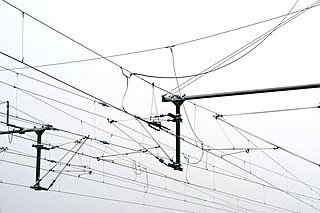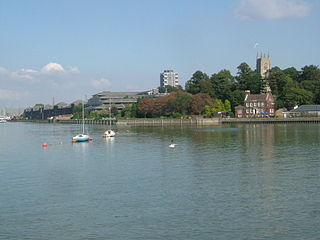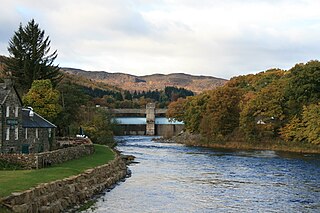
In rail transport, a train is a series of connected vehicles that run along a railway track and transport people or freight. The word train comes from the Old French trahiner, derived from the Latin trahere meaning "to pull, to draw". Trains are typically pulled or pushed by locomotives, though some are self-propelled, such as multiple units. Passengers and cargo are carried in railroad cars, also known as wagons. Trains are designed to a certain gauge, or distance between rails. Most trains operate on steel tracks with steel wheels, the low friction of which makes them more efficient than other forms of transport.

Electric power transmission is the bulk movement of electrical energy from a generating site, such as a power plant, to an electrical substation. The interconnected lines which facilitate this movement are known as a transmission network. This is distinct from the local wiring between high-voltage substations and customers, which is typically referred to as electric power distribution. The combined transmission and distribution network is part of electricity delivery, known as the electrical grid.

An overhead line or overhead wire is an electrical cable that is used to transmit electrical energy to electric locomotives, trolleybuses or trams. It is known variously as:

The River Medway is a river in South East England. It rises in the High Weald, East Sussex and flows through Tonbridge, Maidstone and the Medway conurbation in Kent, before emptying into the Thames Estuary near Sheerness, a total distance of 70 miles (113 km). About 13 miles (21 km) of the river lies in East Sussex, with the remainder being in Kent.

The Warsaw Radio Mast was a radio mast located near Gąbin, Poland, and the world's tallest structure at 646.38 metres (2,120.7 ft) from 1974 until its collapse on 8 August 1991. Designed by Jan Polak, and one of the last radio masts built under Soviet rule, the mast was conceived for height and ability to broadcast the "propaganda of the successes" to remote areas such as Antarctica. It was the third tallest structure ever built, being surpassed as the tallest by the Burj Khalifa tower in the United Arab Emirates in 2009 and Merdeka 118 tower in Malaysia in 2022.
The table below lists many of the tunnels under the River Thames in and near London, which, thanks largely to its underlying bed of clay, is one of the most tunnelled cities in the world. The tunnels are used for road vehicles, pedestrians, Tube and railway lines and utilities. Several tunnels are over a century old: the original Thames Tunnel was the world's first underwater tunnel.

A transmission tower, also known as an electricity pylon or simply a pylon in British English and as a hydro tower in Canadian English, is a tall structure, usually a steel lattice tower, used to support an overhead power line.
The HVDC Inter-Island link is a 610 km (380 mi) long, 1200 MW high-voltage direct current (HVDC) transmission system connecting the electricity networks of the North Island and South Island of New Zealand together. It is commonly referred to as the Cook Strait cable in the media and in press releases, although the link is much longer than its Cook Strait section. The link is owned and operated by state-owned transmission company Transpower New Zealand.

In the electricity sector in the United Kingdom, the National Grid is the high-voltage electric power transmission network serving Great Britain, connecting power stations and major substations and ensuring that electricity generated anywhere on it can be used to satisfy demand elsewhere. The network covers the great majority of Great Britain and several of the surrounding islands. It does not cover Northern Ireland, which is part of a single electricity market with the Republic of Ireland.

The Hoo Peninsula is a peninsula in Kent, England, separating the estuaries of the rivers Thames and Medway. It is dominated by a line of chalk, clay and sand hills, surrounded by an extensive area of marshland composed of alluvial silt. The name Hoo is a Saxon word believed to mean 'spur of land' or refers to the 'distinct heel-shape of the ridge of hills' through Hoo. Hoo features in the Domesday Book. The peninsula is home to internationally and nationally protected wildlife sites as well as industrial facilities and energy industries.
The Lower Thames Crossing is a proposed road crossing of the Thames estuary close to the Dartford Crossing that links the counties of Kent and Essex, and its proposed approaches. If built it would pass through the districts of Thurrock and Gravesham, supplementing the Dartford route. The approximately 14.3-mile (23.0 km) route will be assessed by the Planning Inspectorate.

The Tummel hydro-electric power scheme is an interconnected network of dams, power stations, aqueducts and electric power transmission in the Grampian Mountains of Scotland. Roughly bounded by Dalwhinnie in the north, Rannoch Moor in the west and Pitlochry in the east it comprises a water catchment area of around 1,800 square kilometres (690 sq mi) and primary water storage at Loch Ericht, Loch Errochty, Loch Rannoch and Loch Tummel, in Perth and Kinross. Water, depending on where it originates and the path it takes, may pass through as many as five of the schemes nine power stations as it progresses from north-west to south-east. The scheme was constructed in the 1940s and 50s incorporating some earlier sites. It is currently managed by SSE plc.
The Saint Lawrence River HVDC Powerline Crossing is the crossing of Hydro-Québec's Quebec-New England HVDC transmission line over the Saint Lawrence River between Grondines and Lotbinière, Quebec, Canada. The crossing is remarkable, for being first implemented as an overhead crossing, and then later replaced by a cable tunnel. Hydro-Québec wanted to complete the transmission line in time, which was only possible with an overhead crossing of Saint Lawrence River. However, due to the negative visual impact of the large towers of the overhead crossing on the local populations of Grondines and Lotbinière, it was decided to build a cable tunnel under the river, although this made the project more expensive.

Sand Patch Grade is an approximately 100-mile-long (160 km) section of railroad track known for its steep grades and curves through the Allegheny Mountains of Pennsylvania and Maryland. Dropping over 1,000 feet (300 m) in about 20 miles (32 km) and with grades as much as 2%, Sand Patch Grade is one of the steepest railroad grades on the East Coast.
Passive survivability refers to a building's ability to maintain critical life-support conditions in the event of extended loss of power, heating fuel, or water. This idea proposes that designers should incorporate ways for a building to continue sheltering inhabitants for an extended period of time during and after a disaster situation, whether it be a storm that causes a power outage, a drought which limits water supply, or any other possible event.
Powerline river crossings comprise both overhead lines and cable tunnels beneath rivers and estuaries. Overhead power lines are supported on towers which are usually significantly taller than overland pylons and are more widely spaced to cross the river in a single span. Tall pylons ensure that the electricity cables which they support provide an adequate safety clearance for river traffic.
The Severn-Wye Cable Tunnel, also known as the Severn Cable Tunnel, carries high-voltage electricity transmission lines beneath the estuaries of the River Severn and River Wye between Newhouse (Mathern), Monmouthshire and Aust, South Gloucestershire.
Huddersfield power station supplied electricity to the town of Huddersfield and the wider area from 1893 to 1981. It was owned and operated by Huddersfield Corporation until the nationalisation of the electricity supply industry in 1948. The power station was redeveloped several times: including the incorporation of new plant in the 1910s, and in the 1930s to 1950s. The station was decommissioned in October 1981.
Gridlink Interconnector is a proposed submarine power cable between England and France. The 1,400 MW HVDC connector would link Kingsnorth National Grid substation in north Kent, England, with RTE Warande substation in Bourbourg (Nord) near Dunkirk in northern France.

Slovenská elektrizačná prenosová sústava (SEPS) is the electricity transmission system operator in Slovakia.











